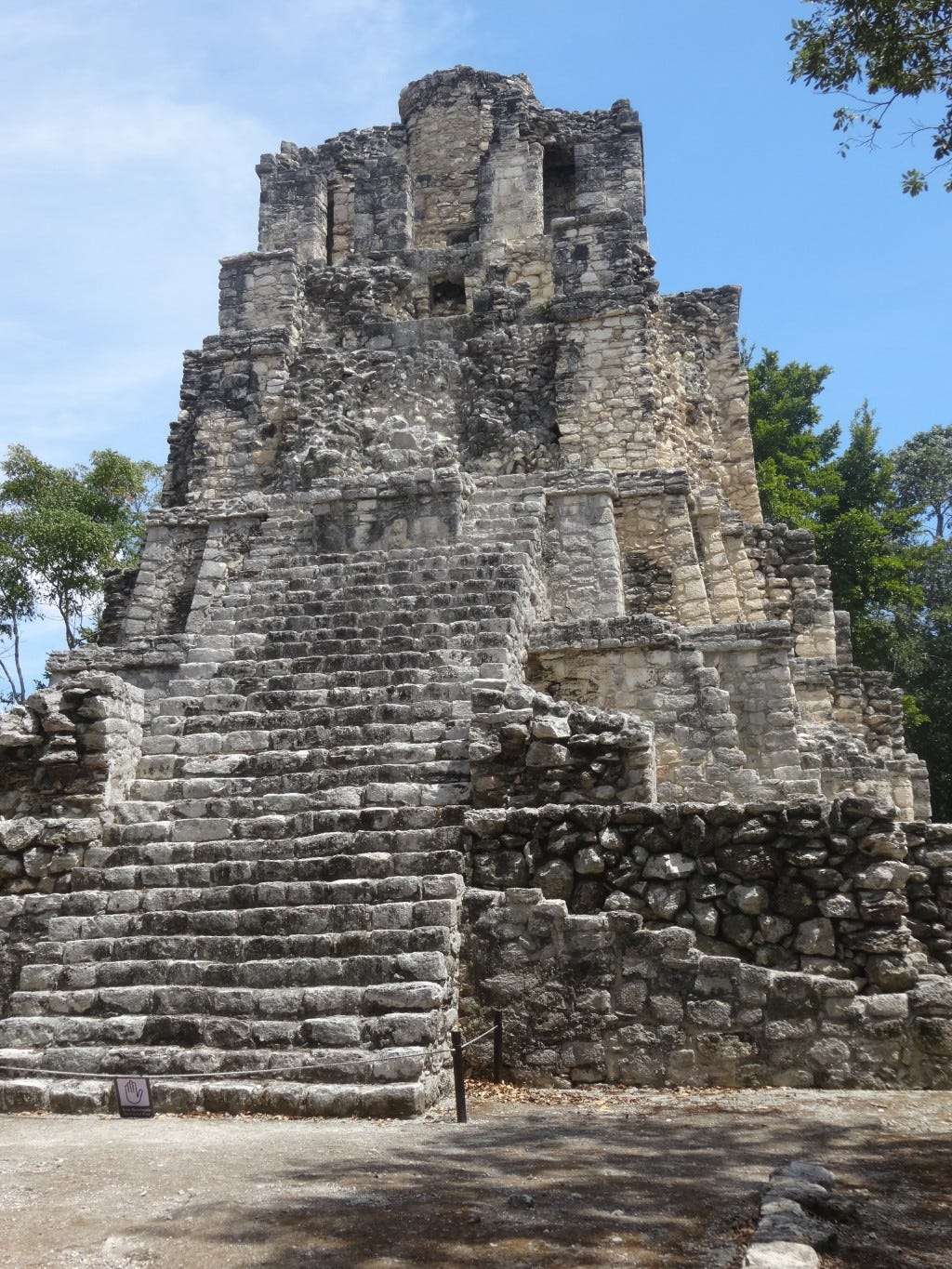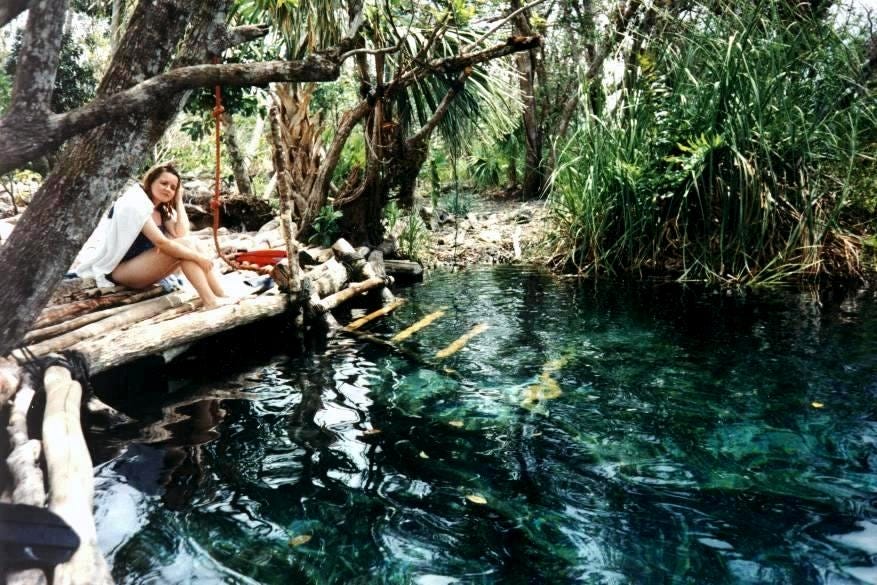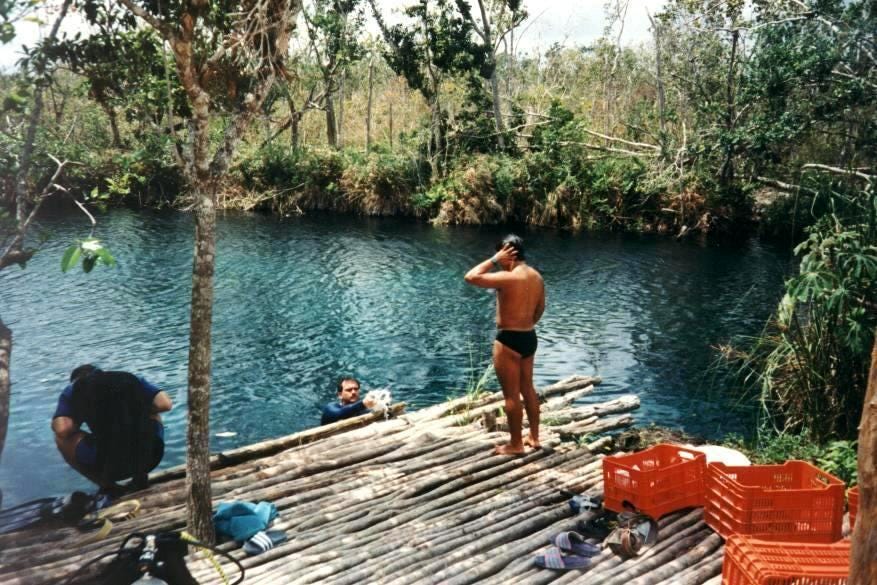On the Road to More Ruins
A Small Village, Ancient Structures, Crystal-Clear Cenotes - Travel Tales from the Land of the Maya #5
After exploring the ruins, we spent the night in the village of Tulum. From there, we drove inland in search of more Maya ruins, and everything else we would find along the road.
Dear Reader,
Welcome to another installment of my future travel memoir about exploring the land of the Maya (both ancient structures and present-day towns). If you are new here, you can find the series on the navigation bar of the site, under Travel Tales from the Land of the Maya.
In 1995 Tulum was a small Maya village, most of it lined up along the two-lane main road, with a hotel or two, and just as many restaurants. Larger than some of the tiny settlements we passed since Puerto Morelos, it also had a bank, a panaderia (bakery), and a tienda (small store selling essentials), which meant we always stopped there to refuel - buy essentials before heading inland.
After an overnight stay in town, we drove down the road to the tiny ruins of Chunyaxche (also known as Muyil). A small - and empty - parking lot along the road south of Tulum signaled the opportunity to stop and visit the ruins Jeff knew about from his previous trips (and from books). No ticket booth, no entry fee. Once we passed the gate, we walked through the structures, with no particular signs of what was what - we could only guess.
Most of the site was enveloped in jungle vegetation. The first structure we noticed, in the center of the plaza we entered, was the Castillo, a tall, but narrow, pyramid in rubble. We climbed it (as far as it was safe), only guessing what lay under the rubble we scrambled through.
Two decades later, we found out:
* The reconstructed pyramid is based on photographs from the Mason-Spinden expedition (23.49min), dating from 1926, and described in the book Silver Cities of Yucatan.
Standing 57 feet tall, the Castillo of Muyil is the tallest pyramid on the coast of the Yucatan Peninsula. It is also the oldest, much older than any of the structures in Tulum or Xel-Ha.
Built in terraces, it dates from the Terminal Classic period of the ancient Maya civilization. Indeed, it looks more like a classic pyramid, though we couldn’t tell when we first saw it.
Most of the structures, including the pyramid, were in rubble. A few smaller temples sat in the main plaza surrounding the Castillo, and the rest were in the jungle, along a narrow path surrounded by thick vegetation.
Muyil is the oldest of the sites along the coast, much older than its main pyramid, with some of its structures dating from the Early Classic period of the Maya civilization. Since people still lived here when the Spaniards showed up on the Peninsula, it was the city inhabited the longest along this shore. Archaeologists believe people lived in the city from about 300 BC to the 1550s.
But the jungle covers many more buildings than the ones we see even today.
Walking under the canopy of ceiba and chicle trees, among others, we often noticed mounds with unnatural-looking stone blocks peaking out from under the dense vegetation. We knew they were part of an ancient structure.
The only uncovered structure I remember from that first trip was Temple 8, at the end of a short trail from the Castillo. Well-preserved, and excavated, the temple on top of a tiny pyramid held some colorful murals.
We walked into the single room, then sat on the stairs of the small temple for a short break. Thick jungle surrounded us in every direction.
“There is a lagoon somewhere near this site,” said Jeff. “I’d love to find it again.”
We saw no discernible trail besides the one we came from, and we didn’t want to chance getting lost in the jungle, so we headed back.
A local Maya child of about eight walked by along the trail.
“Laguna?” Jeff asked him after he greeted us.
“Si, quieres ir a la laguna?” he asked with a huge smile on his face.
“Si,” we answered.
The child started off on a trail he could only see, motioning us to follow him. We walked with this child in a thick jungle, listening to him chatter (and understanding almost none of it) for a short time before we got to the water’s edge. The lagoon was so quiet, we instinctively stopped talking.
We stood on a wooden dock at the edge of the lagoon. A slight breeze added waves to the still water, and sent the ripples all the way to the dock and the shore.
Eventually, we made our way back, said goodbye to our new friend, and drove on.
We drove back towards Tulum, and, from there, headed inland.
When driving in Yucatan, you inevitably pass several cenotes along the way.
The first one we stopped at was the Carwash Cenote. The name doesn’t mean they washed cars in it. Instead, most likely, because it was literally on the side of the road, close enough to wash your car in it. We were the only car that stopped there, so we had the cenote all for ourselves.
As we were leaving, a van stopped by. Several people got out and took diving gear with them. Talking to them, we found out about the cave system under the water. As mysterious and exciting as it sounded, my fear of deep water prevented me from even thinking of trying it. We watched them diving into the cenote and eventually their lights disappearing in the depths.
A few miles down the road, the Grand Cenote offered a different experience, more of my speed. Here, the water was shallow, most of it in a cave. A large, open cave. Of course, I enjoyed this more - at least being in the water -, but I missed the mystery of the deep waters of the Carwash cenote.
Eventually, we drove on along the narrow road towards Coba.









This is great armchair travel!
What fun! Get to travel down memory lane, at least part of the way, with you, Emese.I never say either Muyil or Chumyaxche? spelling? It is GORGEOUS second time around. Very different --and I look forward to your route as you head inland!